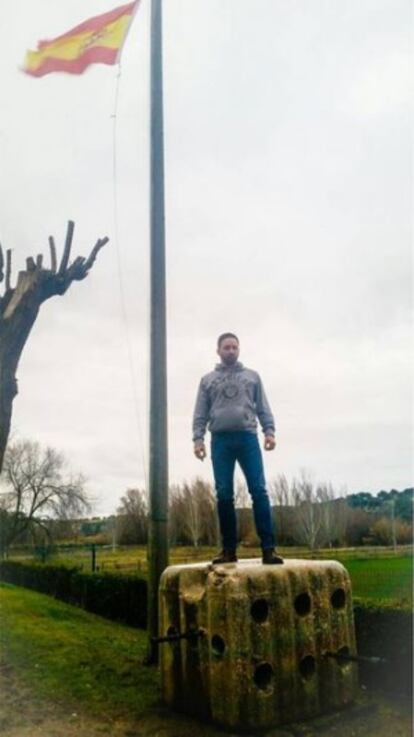Arrest made as Gibraltar searches for its “stolen” concrete block
Cádiz man refusing to speak to Royal Police over removal of part of controversial offshore reef


Leoncio Fernández, a fisherman from La Línea de la Concepción (Cádiz), had an appointment with the Royal Gibraltar Police on Tuesday. The authorities in the UK territory wanted to take a statement from him about the illegal removal of a concrete block that Gibraltar had dumped into the sea off its coast with the aim of creating an artificial reef.
“I have no plans on appearing,” Fernández says. “I have nothing to tell them.”
Gibraltar police arrested Fernández in October after officers determined that he was one of people responsible for removing the concrete block in the summer of 2014.
The Gibraltar government dumped 70 blocks in the Bay of Algeciras in 2013 to help create an artificial reef around the territory. At the time, the Spanish government of Prime Minister Mariano Rajoy lodged a protest, accusing Gibraltar of “environmental crimes” and violating “international rights in Spanish waters.”
Spain does not recognize Gibraltar’s maritime claims in the waters surrounding the territory.
Tensions were heightened when Gibraltarian police confronted a large group of Spanish fishermen who were staging a protest in the middle of the bay. They complained that the reefs prevented them from trawling in the location because their nets were getting caught on the blocks.
Santiago Abascal, then-leader of the far right group Foundation for the Defense of the Spanish Nation (Danaes) and current spokesperson for right-wing party Vox, has acknowledged the removal of the block.
I don’t know anything about that block nor do I know those people” Fisherman Leoncio Fernández
“I don’t know anything about that block nor do I know who those people are,” Fernández says.
But two years ago, he told the press that with the help of professional divers they were able to bring up one of the blocks from the sea.
“I didn’t take part in any of that. It is true that I was there because I had been told beforehand but my boat wasn’t used and that can be proved by looking at the geolocation data,” he says.
Fernández claims he was arrested when he went to police headquarters in Gibraltar.
“My son entered Gibraltar with my boat for refueling. Once he was there, various police officers came on board asking for me. That’s when I found out there was an arrest warrant,” he explains.
According to Fernández, they detained him “for hours” and ordered him to return on Tuesday to give a statement.
British police sources say that the investigation is still ongoing.
Meanwhile, Abascal has been using social media to defend the protest actions.
“In June 2014, we [took the concrete block] from the bottom of the sea to demonstrate that it was possible to do so, and to demand strong action from the Spanish government. We still have it in our possession,” he wrote on Instagram.
Along with the message, he also posted a photo last week of him standing on a block that was reportedly moved to a farm in Spain.
According to the spokesperson from Vox – which was created by former Popular Party members who were unsatisfied with the group’s policies – Gibraltar has asked the Interpol for help rounding up all the suspects in the incident. The Royal Gibraltar Police has declined to comment on this.
English version by Martin Delfín.
Tu suscripción se está usando en otro dispositivo
¿Quieres añadir otro usuario a tu suscripción?
Si continúas leyendo en este dispositivo, no se podrá leer en el otro.
FlechaTu suscripción se está usando en otro dispositivo y solo puedes acceder a EL PAÍS desde un dispositivo a la vez.
Si quieres compartir tu cuenta, cambia tu suscripción a la modalidad Premium, así podrás añadir otro usuario. Cada uno accederá con su propia cuenta de email, lo que os permitirá personalizar vuestra experiencia en EL PAÍS.
¿Tienes una suscripción de empresa? Accede aquí para contratar más cuentas.
En el caso de no saber quién está usando tu cuenta, te recomendamos cambiar tu contraseña aquí.
Si decides continuar compartiendo tu cuenta, este mensaje se mostrará en tu dispositivo y en el de la otra persona que está usando tu cuenta de forma indefinida, afectando a tu experiencia de lectura. Puedes consultar aquí los términos y condiciones de la suscripción digital.
Últimas noticias
From Andorra to Gibraltar, a black market for Ozempic exploits its success: ‘They’re the most sought-after products in the world’
Magnets in their heads: How some animals guide themselves using the Earth’s magnetic field
From Hungary’s Orbán to Chile’s Kast: How Trump helps turbo charge the far right
The brief rise and retreat of Generation Z in Mexico
Most viewed
- Why we lost the habit of sleeping in two segments and how that changed our sense of time
- Trump’s obsession with putting his name on everything is unprecedented in the United States
- Charles Dubouloz, mountaineering star, retires at 36 with a farewell tour inspired by Walter Bonatti
- Venezuela faces its most tense Christmas yet
- The Florida Keys tourist paradise is besieged by immigration agents: ‘We’ve never seen anything like this’








































